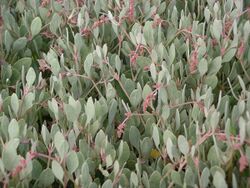Biology:Halimione portulacoides
| Halimione portulacoides | |
|---|---|

| |
| Scientific classification | |
| Kingdom: | |
| (unranked): | |
| (unranked): | |
| (unranked): | |
| Order: | |
| Family: | |
| Subfamily: | |
| Genus: | |
| Species: | H. portulacoides
|
| Binomial name | |
| Halimione portulacoides (L.) Aellen
| |
Halimione portulacoides or sea purslane (2n=36) is a small greyish-green shrub widely distributed in temperate Eurasia and parts of Africa.[1]
A halophyte, it is found in salt marshes and coastal dunes, and is usually flooded at high tide.
The plant grows to 75 cm. It is evergreen, and in northern temperate climates it flowers from July to September. The flowers are monoecious and are pollinated by wind.
The edible leaves can be eaten raw in salads or cooked as a potherb. They are thick and succulent with a crunchy texture and a natural saltiness.[2] The leaves are good for human and animal health as they contain important micronutrients like zinc, iron, copper, and cobalt.[3]
Distribution
Halimione portulacoides occurs at the sea shores of western and southern Europe, and from the Mediterranean Sea to western Asia.[4]
Ireland
Copeland Islands (Co. Down).
Systematics
Botanical synonyms include Atriplex portulacoides L. and Obione portulacoides (L.) Moq. Recent phylogenetic research revealed, that Halimione is a distinct genus and can not be included in Atriplex.[5]
References
- ↑ "Atriplex portulacoides". The Plant List. http://www.theplantlist.org/tpl/record/kew-2665685.
- ↑ "Halimione portulacoides Sea Purslane PFAF Plant Database". pfaf.org. http://www.pfaf.org/user/Plant.aspx?LatinName=Halimione+portulacoides.
- ↑ "Functional Food from Endangered Ecosystems: Atriplex portulacoides as a Case Study". Foods 9 (11): 1533. October 2020. doi:10.3390/foods9111533. PMID 33114436.
- ↑ "Chenopodiaceae (pro parte majore).". Euro+Med Plantbase - the information resource for Euro-Mediterranean plant diversity.. 2011. http://ww2.bgbm.org/euroPlusMed/PTaxonDetail.asp?UUID=B289DD77-EEFE-4C56-A404-0265D9519DFD.
- ↑ "Molecular phylogeny of Atripliceae (Chenopodioideae, Chenopodiaceae): Implications for systematics, biogeography, flower and fruit evolution, and the origin of C4 photosynthesis". American Journal of Botany 97 (10): 1664–87. October 2010. doi:10.3732/ajb.1000169. PMID 21616801.
External links
| Wikimedia Commons has media related to Halimione portulacoides. |
Wikidata ☰ Q888227 entry

